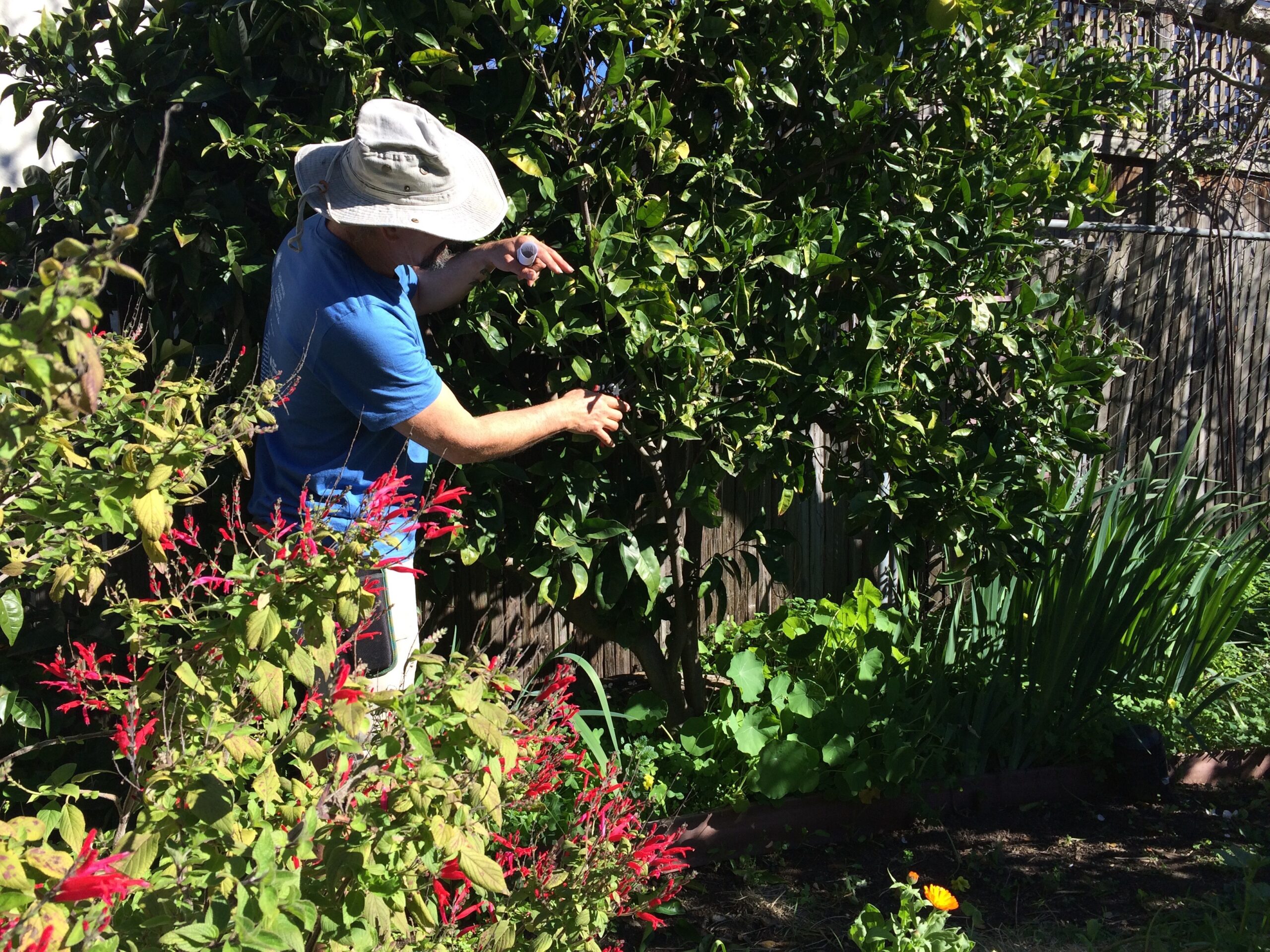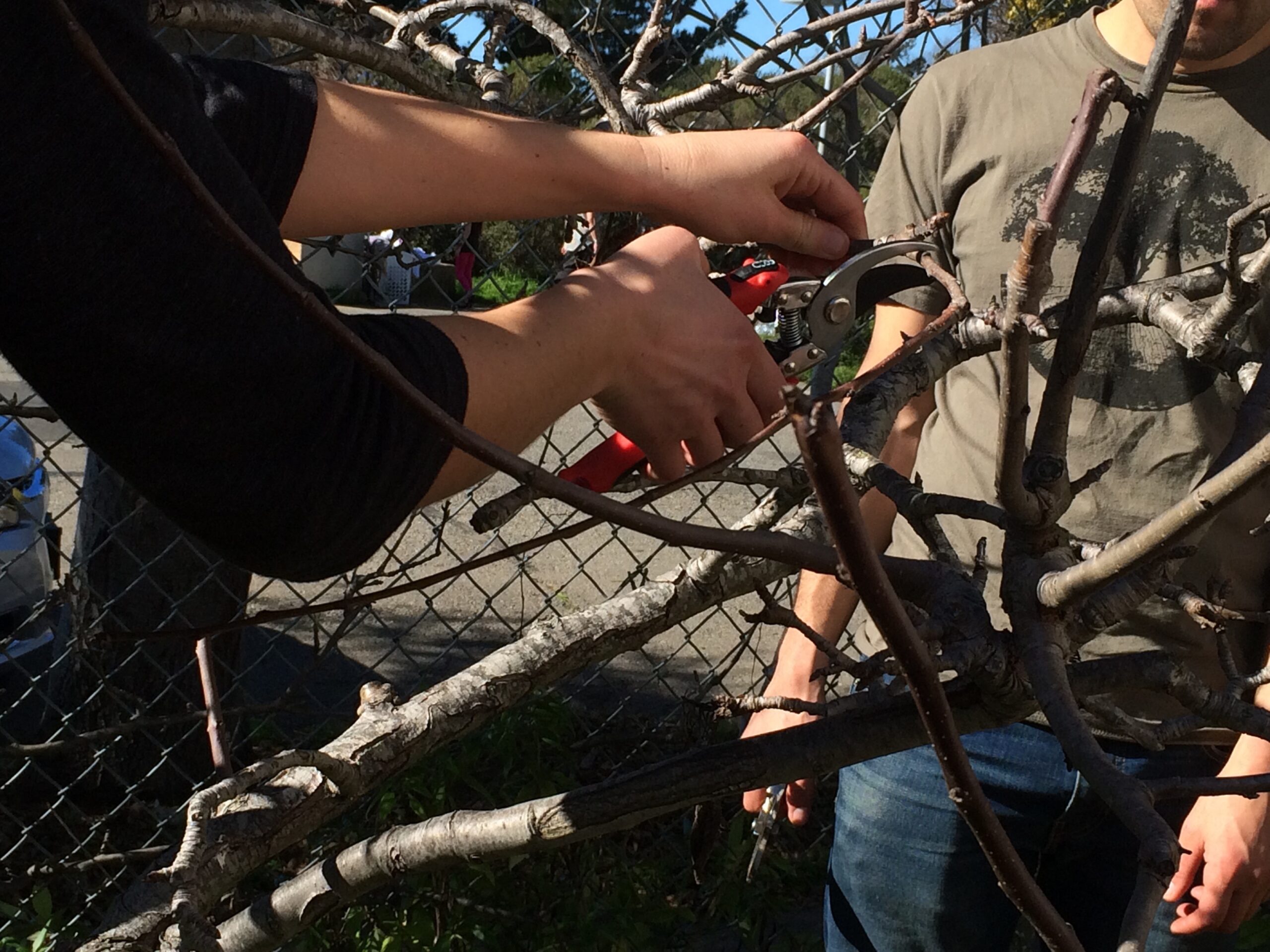This article was written by James Hosley of the Ecology Center Help Desk.
Why We Prune:
The purpose of pruning is to shape trees or woody shrubs, so that they are healthier and more aesthetically pleasing (it looks the way I want it to look!). This requires shaping the plant’s “bones” or structure, which means primarily cutting and removing unwanted branches, stems, and twigs. Pruning can allow you to direct the plant’s growth (controlling its shape). Good pruning also encourages a fruit bearing plant to produce fewer but larger fruit, and often provides easier access for harvesting. Fruit bearing trees, vines and bushes are usually deciduous, characterized by broad leaves that seasonally drop, in the Fall. A few examples are flowering/fruit bearing trees (e.g. apples, persimmons or pears), fruiting vines (e.g. grapes or blackberries), shrubs (currants), and rose bushes. Ornamental evergreens, such as yews, boxwood, arborvitae, or azalea, also need pruning, mostly for shaping, since they don’t bear edible fruit. The exception to all of the above, is to remove dead or diseased wood, as soon as it is noticed, year-round.
Why Prune in Winter:
In winter, the sun’s path is lower on the horizon, so days are shorter. More importantly, even when the sun is shining, it provides less energy in the form of light and heat. During those colder days of winter, a plant’s sap moves more slowly. Since it’s getting fewer nutrients, the plant grows slower and may go dormant. Generally, the best time to prune deciduous trees is the very end of winter weather, when the buds are just starting to swell, but before they have started to break open. This is an ideal time to prune because most of the leaves are gone, the sap isn’t flowing yet, and the underlying branches of the plant are probably now fully visible. In terms of plant health, a cut results in bleeding, thus pruning in late winter means the dormant plant will lose less sap and be less susceptible to damage from insects, mold, virus, and other pathogens, attracted to the open wound.
Best Days to Prune:
Not all winter pruning days are created equal. Dry days are best for pruning because they allow for quicker grow-over, or “healing” from a pruning cut lessening the amount of time the scars would be open to the weather. Rainy days, and the days thereafter, may also allow transmission of mold or viruses.
How to Prune:
Pruning, at its best, is a highly skilled art form. Two of the key principles are to remove any dead material and to shape the plant so as to reduce density in the plant’s center (open it to light). A good rule of thumb is to start by considering the removal of any branch that grows straight up, straight down, or crosses another. The dense interior growth of a tree or shrub means that the interior gets less light and air, producing inferior fruit which extracts nutrients from the plant. Removing some central branches allows remaining fruit and branches to grow stronger and bear potentially tastier fruit that may also be more easily harvested.
One healthy practice is that you should clean off your pruning tools after cutting each plant to avoid spreading any disease from plant to plant.
The art of good pruning should be practiced by those who care about plants. It is not hacking away growth or branches for quick effect but rather about seeing the plant, the healthy, future growth of the plant (it’s shape), and what the plant might produce in the years ahead.
And remember, winter is also a great time to feed your trees, vines and shrubs, since any winter rains will help to carry the amendments (fertilizers and such) down to the roots of the plant.
Learn More
Visit your Local Nursery
- One of the best resources for any gardening question may be the staff at a local nursery, since they are familiar with the local climate, soil, and indigenous plants of your neighborhood
Subscribe to our EcoCalendar Newsletter
- The Ecology Center EcoCalendar can direct you to upcoming workshops on pruning. During the COVID-19 pandemic, most workshops are online, so it’s possible to attend from almost anywhere!
- There is an Urban Orchard Intensive coming-up on Saturday, January 30th, 10am – 4pm (with a fee). It has a 1.5 hour “Fruit Tree Pruning” segment (which can be taken alone).
Read!
- The Ecology Center Store has a variety of books and supplies available to support your pruning and gardening endeavors. Stop by for in-person browsing or visit our online shop for no-contact pickup. As an Ecology Center member, you always receive 10% off your purchase of regularly priced items and 20% off books purchased in-store. Not a member yet? Become a member today and save! .
- Borrow from our Lending Library. Our library is open to everyone for reference. If you are an Ecology Center member, you can check out items. Members may browse and check out books from the library while in store, or may review our online catalog and place an email request to check-out books for pick up. Not a member yet? Become a member today!
- Here are our favorites from our Lending Library:
- From Tree to Table: Growing Backyard Fruit Trees in the Pacific Maritime Climate, by Barbara Edwards and Mary Olivella (Be-94) (2011)
- The Home Orchard, University of California Ingels et al Be-182) (2007)
- An All Illustrated Guide to Pruning, by Edward F Gilman (Be-166) (2002)
- Other recommendations:
- The Complete Pruning Guide, which reviews a variety of pruning books and makes recommendations.
- Why Late Winter Is the Best Time to Prune
- Sunset Western Garden Book





